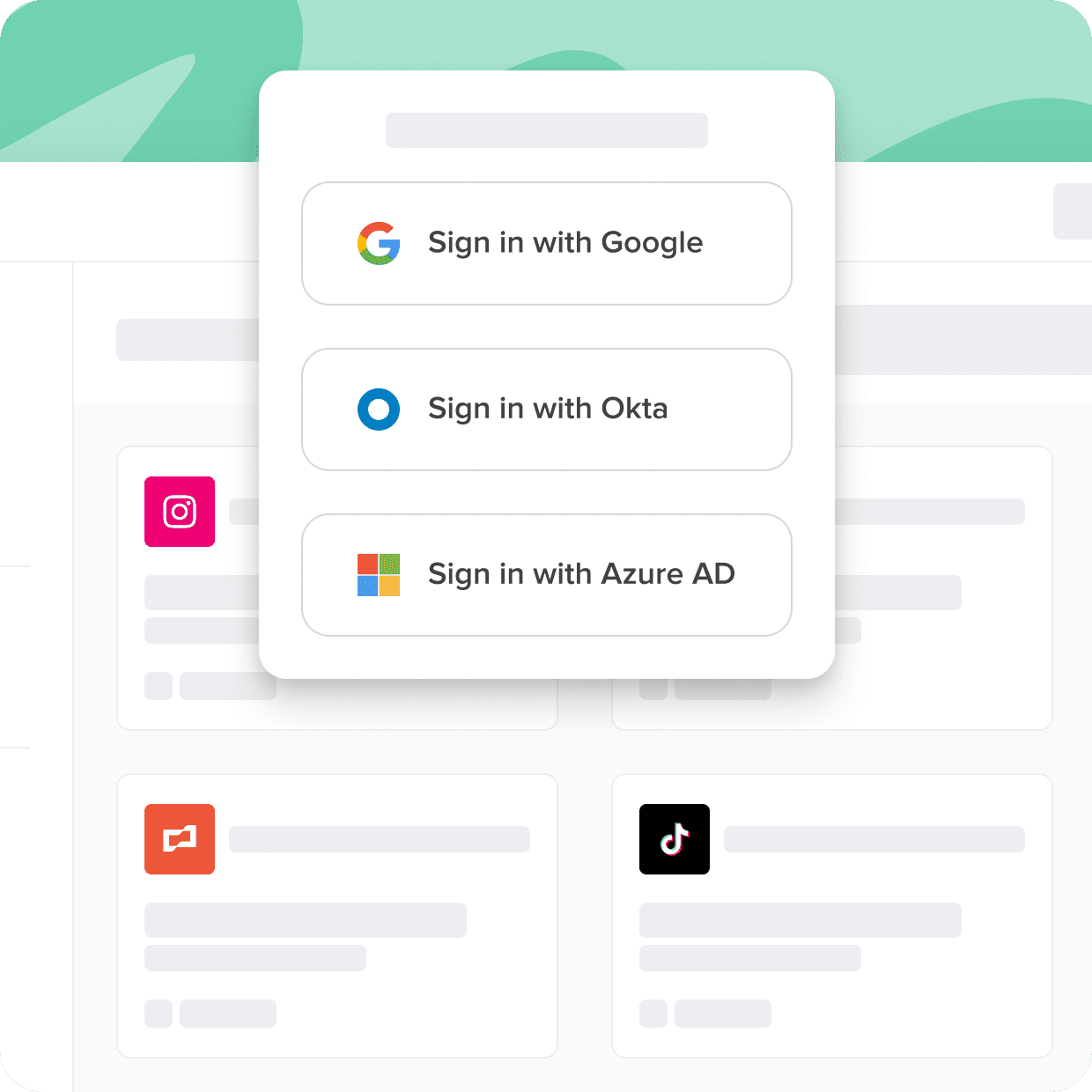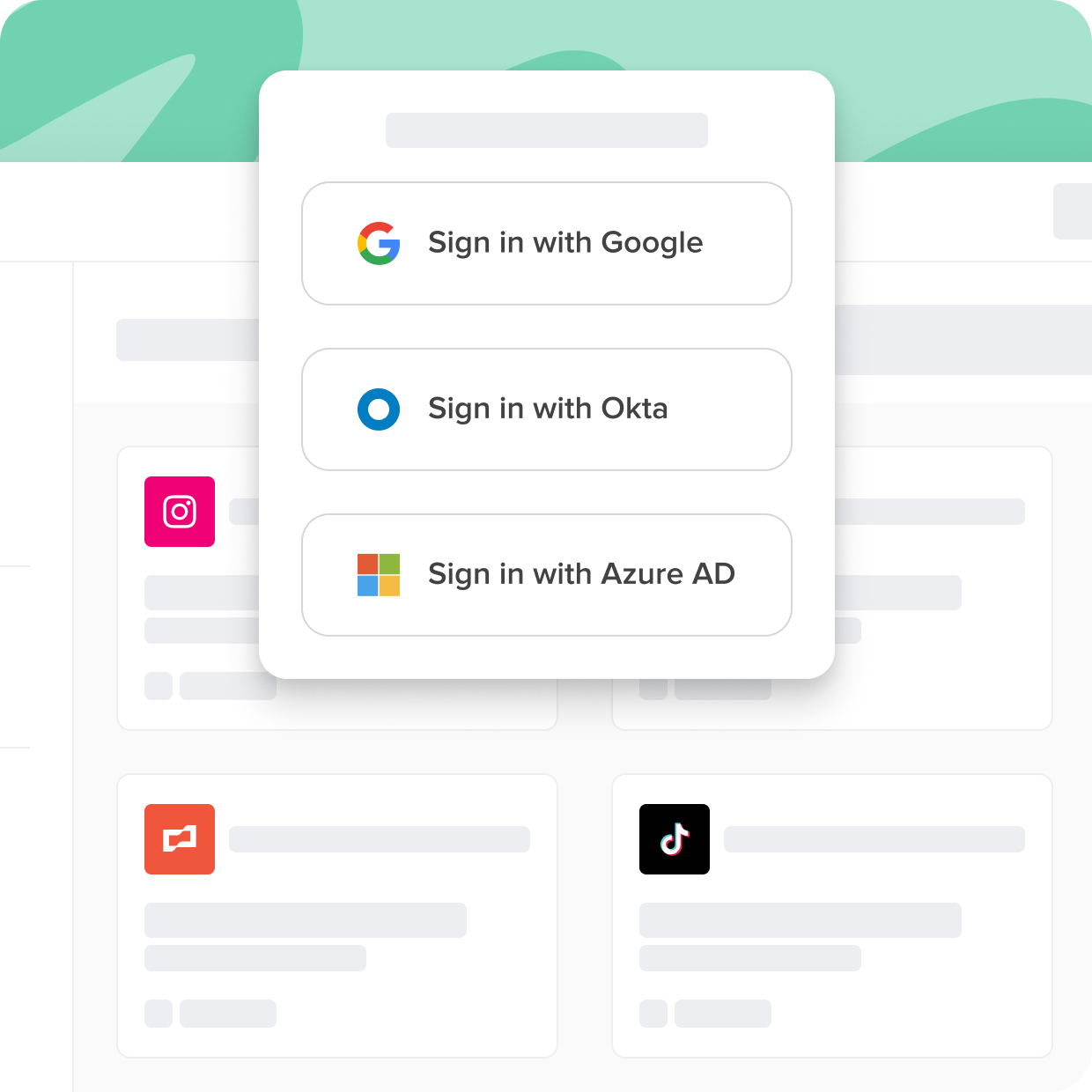User access management tools provide the means to control access to valuable resources, data, and applications, while Single Sign-On (SSO) simplifies authentication by allowing users to log in once and access multiple applications without needing to authenticate separately for each one.
Unfortunately, many corporate applications don't support the SSO standard and can't reap all the benefits. The applications that fall into this category are best called "nonfederated." Nonfederated applications are a new category that is becoming increasingly challenging for businesses to manage and secure effectively, yet increasingly critical for businesses to succeed.
Cerby connects all of your apps to your SSO tools, even if they don't support the SSO standard. In this guide, you'll learn about SSO software, the history, and the benefits.
Streamline Access With Single Sign-On
Not all apps are created equal. Some come with security gaps and complexities that can hinder user adoption and put sensitive data at risk. With Cerby, you can ensure secure and seamless access to all your applications, regardless of their support for standards like SSO.
With Cerby You Can
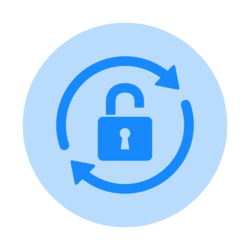
Close the identity gap
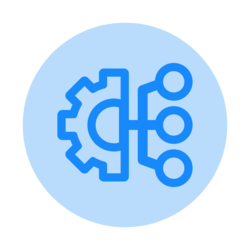
Universally enforce 2FA
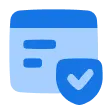
Eliminate the SSO tax
User Access Management Tools
User access management tools provide the means to control access to valuable resources, data, and applications. With the increasing complexity of IT systems and the growing threat of cyber attacks, robust user management solutions have become more crucial than ever. These tools help to ensure that only authorized users can access sensitive information, thereby protecting the organization from unauthorized access and other security risks.
An access management system is a set of tools and processes designed to manage access to digital resources. These systems enable administrators to define user roles and track user activity, granting everyone the appropriate level of access based on their respective roles. By implementing a robust access management system, organizations can achieve a higher level of security and compliance. To highlight the importance of an access management strategy, the Ponemon Institute held a research study analyzing 595 IT and security practitioners in the United States that are involved in their organization’s identity and access management strategy. This research uncovered that organizations are struggling to reduce the cybersecurity risks caused by shared accounts and that half of the respondents enable employees to share login credentials. However, only 27% of the organizations that share accounts are effective in reducing cybersecurity, meaning that the remaining 73% are high-risk organizations for cyber attacks.
User access management solutions offer several key benefits, including:
- Enhanced security: By controlling user access to resources, organizations can significantly reduce the risk of unauthorized access and data breaches.
- Improved compliance: Regulations such as the General Data Protection Regulation (GDPR) and the Health Insurance Portability and Accountability Act (HIPAA) require organizations to implement strict controls over access to sensitive data. User access management tools help organizations meet these regulatory requirements by providing a framework for managing and controlling access to sensitive information.
- Streamlined user management: User access management tools simplify the process of managing user accounts, permissions, and roles. Administrators can easily modify access, responding quickly to changing business needs.
- Increased efficiency: Automating the process of granting and revoking access is a great way for organizations to save time and resources. This increased efficiency can translate into cost savings and improved productivity.
- Comprehensive monitoring and reporting: Access management tools often include advanced monitoring and reporting capabilities. This allows administrators to track user activity and identify potential security risks before they spiral out of control.
Keycloak
User access management solutions come in various forms. Some of the most popular tools include SailPoint Compass, Keycloak, and Microsoft Identity Manager. SailPoint Compass is a comprehensive identity governance platform that enables organizations to manage user access across systems and applications.
- SailPoint IdentityIQ, also offered through SailPoint, is a leading identity governance solution that gives organizations the ability to manage user access, automate compliance processes, and monitor user activity. In addition to SailPoint IdentityIQ and SailPoint Compass, SailPoint offers SailPoint IdentityNow. This solution helps organizations manage access, ensure compliance, and mitigate security risks.
- Keycloak is an open-source identity and access management solution that offers features such as single sign-on (SSO), multi-factor authentication (MFA), and social login support. Keycloak allows businesses to secure their applications and services and provides benefits such as flexibility and ease of integration with existing systems.
- Microsoft Identity Manager is a robust user access management solution that integrates with Microsoft's ecosystem. It includes features like role-based access control, self-service password reset, and automated provisioning and de-provisioning of accounts. The benefits of Microsoft Identity Manager are extensive, making this solution one of the best on the market.
- OpenIAM, an open-source identity, and access management platform, is another great solution that offers a robust feature set. These include single sign-on, access governance, and user lifecycle management.
Apache Syncope
Open-source options for user access management offer a cost-effective and customizable alternative to proprietary solutions. These systems generally provide similar features and capabilities as commercial products but are available under open-source licenses, allowing for greater flexibility and adaptability. Popular open-source user management systems include Apache Syncope and Open Identity Platform.
Apache Syncope is an open-source user management system designed for managing users, groups, and roles across various applications and services. Key features include role-based access control and password management. Open Identity Platform is another system that offers features such as single sign-on, multi-factor authentication, and access governance. A key advantage of Open Identity Platform is its modular architecture, enabling easy customization and integration with existing systems.
The open-source access management and open-source identity governance landscape is constantly evolving, and new solutions are entering the space on a near-daily basis. While Apache Syncope and Open Identity Platform represent two vital systems on the market today, they are but two solutions in a vastly diverse ecosystem. As such, organizations should carefully research different platforms before deciding on a solution for access management.
Azure Identity Management
The rising popularity of cloud-based identity and access management solutions can be attributed to the increasing adoption of cloud services and the need for efficient user management systems. These solutions make it easier to manage user access to resources across multiple platforms and devices. Azure identity management, along with other notable cloud-based options, is a great example of a platform that offers advanced features to simplify processes.
Azure Identity and Access Management is a cloud-based solution by Microsoft. It is designed to simplify user management, enhance security, and facilitate regulatory compliance. The adoption of Azure has been fueled by its seamless integration with other Microsoft services, like Azure Active Directory and Microsoft 365. This integration allows organizations to manage user access across their entire Microsoft ecosystem, ensuring end-users a consistent and secure experience.
Other notable cloud-based identity and access management solutions include Okta, OneLogin, and SailPoint IdentityNow. These solutions offer similar features and benefits as Azure IAM, such as SSO, MFA, and RBAC, along with additional capabilities tailored to specific use cases or industries. These options grant organizations the flexibility to choose a solution that best fits their unique requirements and preferences.
Identity Management Tools
Specialized identity and access management tools play a crucial role in addressing specific aspects of identity and access. These tools focus on certain elements of IAM, allowing businesses to implement targeted solutions that complement their broader identity management strategy. Identity governance and administration vendors offer many different types of tools that cater to the unique needs of organizations in managing user access.
In addition to identity governance, identity management tools and physical identity and access management solutions may help with certain administrative aspects of identity management. By deploying such tools, companies can improve the user experience and manage user accounts more effectively. Considering the number of solutions available today, however, choosing between them can be difficult. Here’s what to look for in a solution:
- Functionality and features: Evaluate the features and capabilities of each identity management tool to determine if it meets your organization's needs. Look for features such as MFA and identity governance. Ensure that the tool supports the desired level of granularity in access control and can be easily configured to match your organization's requirements.
- Integration capabilities: Your tool of choice should integrate seamlessly with your existing systems and applications. For example, it should be compatible with your directory services, cloud services, and other critical applications. The integration will allow for a unified and centralized approach to managing user access across your entire IT infrastructure.
- Scalability: The identity management tool should be able to scale with your organization as it grows or changes. This means it can handle increasing users, applications, and resources without compromising performance or security.
- Compliance and security: Ensure that the identity management tool can help your organization maintain compliance with relevant regulations. Look for features like access certifications, policy enforcement, and auditing capabilities.
- Ease of use and administration: The chosen tool should be user-friendly and provide an intuitive interface for both end-users and administrators.
Top 10 IAM Tools
The top 10 identity and access management tools bring a plethora of features and benefits to the table. These tools are offered by leading IAM software vendors and are designed to address the unique needs and requirements of organizations of all sizes and industries. Here are the top identity and access management tools to consider when choosing a solution:
- Microsoft Azure Active Directory: Azure Active Directory (Azure AD) is a cloud-based IAM solution with features like SSO, MFA, and RBAC.
- Okta: Okta is a popular cloud-based IAM solution. Its flexibility and ease of integration with other platforms make it an excellent choice for organizations looking for a unified and scalable solution.
- SailPoint IdentityIQ: SailPoint IdentityIQ is a leading identity governance and administration tool that offers features like access certification, role management, and policy enforcement.
- OneLogin: OneLogin comes with a number of advanced features, such as user provisioning. It also offers robust security features and integrations and is thus a popular choice among organizations of all sizes.
- CyberArk Privileged Access Security: CyberArk specializes in privileged access management, focusing on securing and monitoring access to sensitive systems and resources.
- ForgeRock: ForgeRock offers a robust identity and access management system that supports a wide range of use cases, including an identity and access management system CMS.
- Ping Identity: Ping Identity’s focus on security and scalability makes it a popular choice for businesses looking to protect their resources and manage user access more effectively.
- IBM Security Identity and Access Assurance: IBM's IAM solution integrates with other IBM security products.
- RSA SecurID: RSA SecurID is a well-established IAM solution that provides strong authentication and access control features.
- Oracle Identity Management: Oracle's IAM suite offers a range of tools designed to help organizations manage user access, enforce security policies, and maintain compliance.
